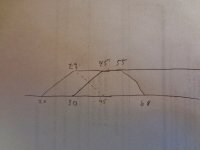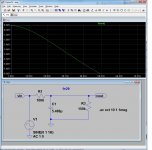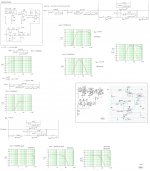I just bought my first powered sub and even when I have it's crossover set to the lowest freq it is infringing on the low region of my main woofer creating a peak. I've been looking for a filter design I could use to restrict the sub but can't seem to find the right circuit.
In the attached drawing I tried to show what I am hearing when running a freq sweep from 20 to 100 hz. The amplitude is kind of ambiguous but basically the bottom line is when the signal is clearly audible and the top line is when the drivers seem to be at their full ouput for the signal level.
The drawing shows the sub starting up at 20hz and reaching full ouput at 29 hz, staying at that level until 55hz and then dropping to 68hz. The main woofer starts out at 30, rises to full output at 45 and then maintains that level.
This gives us a big overlap particularly in the 45 to 55 hz region and I can clearly hear this peak when I do the sweep with both driveres connected.
It seems I'm looking for a filter for the sub to create a drop-off similar to the dashed line I drew.
Input to the filter would be from my pre-amp output (300ohm source impedence). Output of the filter would connect to powered sub speaker level input with 150k load impedence.
Can anyone give some guidance as to what kind of filter I'm looking for here. Schematics or links welcome. Passive or active is OK, whichever will work best.
thanks in advance for any help
Preamp is Aikido
Main speaker: Martin Logan Electromotion esl
sub: REL T5
In the attached drawing I tried to show what I am hearing when running a freq sweep from 20 to 100 hz. The amplitude is kind of ambiguous but basically the bottom line is when the signal is clearly audible and the top line is when the drivers seem to be at their full ouput for the signal level.
The drawing shows the sub starting up at 20hz and reaching full ouput at 29 hz, staying at that level until 55hz and then dropping to 68hz. The main woofer starts out at 30, rises to full output at 45 and then maintains that level.
This gives us a big overlap particularly in the 45 to 55 hz region and I can clearly hear this peak when I do the sweep with both driveres connected.
It seems I'm looking for a filter for the sub to create a drop-off similar to the dashed line I drew.
Input to the filter would be from my pre-amp output (300ohm source impedence). Output of the filter would connect to powered sub speaker level input with 150k load impedence.
Can anyone give some guidance as to what kind of filter I'm looking for here. Schematics or links welcome. Passive or active is OK, whichever will work best.
thanks in advance for any help
Preamp is Aikido
Main speaker: Martin Logan Electromotion esl
sub: REL T5
Attachments
Last edited:
Wanted to mention I'm not just being lazy here. I've been working on this since yesterday searching and trying different things. For example shown below is the result of simple 1st order filter with f=29 and from 29hz on it might not be too bad but freq's below 29 are also attenuated. Isn't there a way I can preserve a flat response below 29 and start the slope down after that? I've chosen several freq's but all seem to attenuate the signal before my starting point.
Attachments
That was a subjective finding, I think.
Phase can throw off your experience or what you hear.
Try one at a time and listen with your ear almost against the driver, as room gain and nulls will also give false results.
So room gain and phase issues are big variables here.
Do you have access to a measurement system?
Phase can throw off your experience or what you hear.
Try one at a time and listen with your ear almost against the driver, as room gain and nulls will also give false results.
So room gain and phase issues are big variables here.
Do you have access to a measurement system?
That was a subjective finding, I think.
Phase can throw off your experience or what you hear.
Try one at a time and listen with your ear almost against the driver, as room gain and nulls will also give false results.
So room gain and phase issues are big variables here.
Do you have access to a measurement system?
Sorry, I didn't mention that I did listen to the sub seperately from the main speaker when I gathered the data that is in the drawing. Also the main speaker and sub are right next to each other. So, I think any phase issues are not contained in that data.
Regarding to listening at the driver I agree that's a good Idea but I wouldn't be able to read the freq numbers displayed on my PC as the sweep is taking place.
I also realize room gain is likely present but as I described when I did the sweep with the sub it rose gradually from 20 to 29 hz and then remained relatively flat until 55 hz and then dropped gradually to 68 where it pretty much dissapeared after that. I didn't hear any resonant peaks while it was 'flat'. Same for my main woofer, it rose gradually from 30 to 45 hz and then reamained relatively flat to the end of the sweep at 100.
I bought the sub to lower the extension from my main speakers. I would like to have it not overlap, which is why I want to reduce the sub's top end. I think any room gain is a seperate issue which may or may not have a similar solution. Unfortunately re-arranging my room is not possible. Too many complications there.
I think it would be worth investigating adding a high pass filter to the amplifiers feeding the main speakers.
They will possibly benefit a lot more by having less bass signal being fed through them.
^^ This.
I think it would be worth investigating adding a high pass filter to the amplifiers feeding the main speakers.
They will possibly benefit a lot more by having less bass signal being fed through them.
Interesting thought. I was going the other direction because my main speakers are more expensive than that the sub so surely they must be better quaility and sound better
Back to your suggestion, not a bad idea. Do you have a circuit in mind? I can do a simple CR network or is there something better?
thanks
CR would work just fine, so just consider R as the input resistance of the amplifier, to give a gentle  slope with the knee starting at 100 Hz
slope with the knee starting at 100 Hz
and Rin=100K a 100nF cap ....correct me if I'm wrong.
So the -3dB point would be located at 80 Hz where is also located the crossover point of the amplifier, giving a flat response by summing .
and Rin=100K a 100nF cap ....correct me if I'm wrong.
So the -3dB point would be located at 80 Hz where is also located the crossover point of the amplifier, giving a flat response by summing .
If you know the roll off frequency of the speaker, then you can choose the roll-off of the passive filter to coincide thus adding the two slopes together and getting the combined Qs.
If as an example the speaker had a Butterworth roll-off at 65Hz for which the Q is 0.7 and you picked the single pole roll-off at the same 65Hz then you get a 3pole roll-off with a net Q of 0.5.
Arrange the bass only to have a matching 3pole & Q= 0.5 and the crossover is complete.
What is much more likely is that the speaker has a "humped" LF response with Q > 0.8.
Now combine that with the passive filter and with a bit of luck you remove the "hump" and still end up with a 3pole roll-off.
or go and look at Linkwitz transform and design an active filter to tune the main speakers to something that has no hump and has better power handling. That would then allow you to cross in the bass only to match the new roll-off of the main speakers.
If you read up Patrick Bateman's posts on QB5 alignment, it gives some clues to what can be done with vented speakers in a box that is far too small. Robert Bullock (in Bullock on boxes) also discussed these types of alignments.
If as an example the speaker had a Butterworth roll-off at 65Hz for which the Q is 0.7 and you picked the single pole roll-off at the same 65Hz then you get a 3pole roll-off with a net Q of 0.5.
Arrange the bass only to have a matching 3pole & Q= 0.5 and the crossover is complete.
What is much more likely is that the speaker has a "humped" LF response with Q > 0.8.
Now combine that with the passive filter and with a bit of luck you remove the "hump" and still end up with a 3pole roll-off.
or go and look at Linkwitz transform and design an active filter to tune the main speakers to something that has no hump and has better power handling. That would then allow you to cross in the bass only to match the new roll-off of the main speakers.
If you read up Patrick Bateman's posts on QB5 alignment, it gives some clues to what can be done with vented speakers in a box that is far too small. Robert Bullock (in Bullock on boxes) also discussed these types of alignments.
bjorno: Thanks for the post. Yes I agree that could be used.
However, I'm beginning to think that what I should really do is use an active Linkwitz Riley type crossover to achieve the best rolloff from sub to main speaker. I'll set the crossover freq somewhere in the region of the overlap between them and connect both main and sub speakers to the appropriate output. This way I'm not trying to match the curve of my main speakers by some filter on the sub.
I see that Marchland Electronics sells a PC board that looks perfect.
XM1 Electronic Crossover Network
However, I'm beginning to think that what I should really do is use an active Linkwitz Riley type crossover to achieve the best rolloff from sub to main speaker. I'll set the crossover freq somewhere in the region of the overlap between them and connect both main and sub speakers to the appropriate output. This way I'm not trying to match the curve of my main speakers by some filter on the sub.
I see that Marchland Electronics sells a PC board that looks perfect.
XM1 Electronic Crossover Network
- Status
- This old topic is closed. If you want to reopen this topic, contact a moderator using the "Report Post" button.
- Home
- Loudspeakers
- Subwoofers
- low pass filter for input to powered sub


